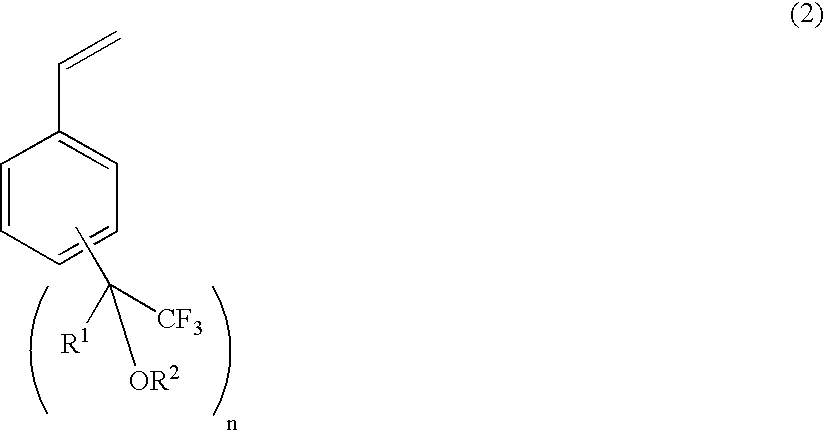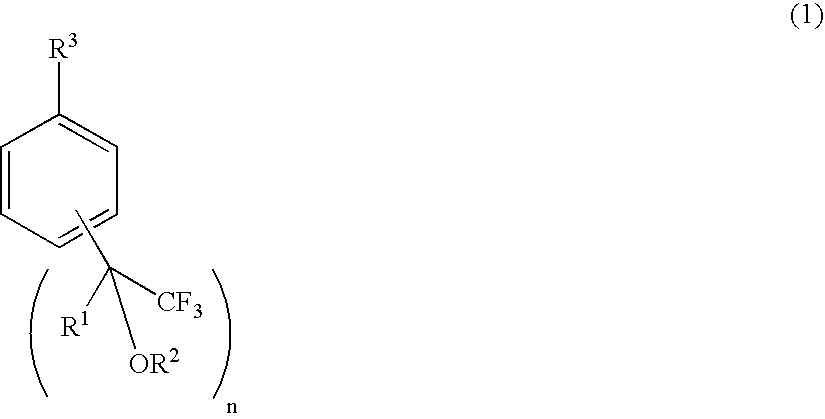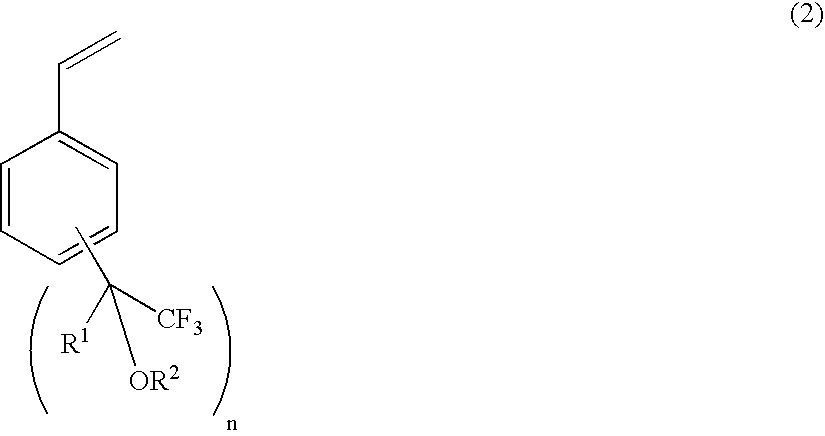Process for producing fluorine-containing, polymerizable styrene monomer and intermediates used in same
a technology of which is applied in the field of process for producing fluorine-containing, polymerizable styrene monomer and intermediate used, can solve the problems of low yield of target products, inferior operation ease, and inferior process as an industrial production process
- Summary
- Abstract
- Description
- Claims
- Application Information
AI Technical Summary
Benefits of technology
Problems solved by technology
Method used
Image
Examples
example 1
[0067]In this example, the target product, 4-HFA-ST (18), was produced by the after-mentioned steps (a), (b) and (c) of the first process, as shown by the following reaction scheme.
[0068]The step (a), trimethylsilylacetylation, was conducted as follows. At first, a three-necked flask (equipped with a reflux condenser and a stirrer) was charged under nitrogen atmosphere with 0.15 g (0.67 mmol) of palladium acetate (Pd(OAc)2), 0.74 g (2.82 mmol) of triphenylphosphine (PPh3) and 0.15 g (0.79 mmol) of cuprous iodide (CuI). Then, 50 ml of a triethylamine (Et3N) solution (containing 21.7 g (67.2 mmol) of a compound of the formula (16)) and 10 ml of a triethylamine (Et3N) solution (containing 7.26 g (73.9 mmol) of trimethylsilylacetylene) were sequentially added to the flask, followed by heating with an oil bath of 100° C. to conduct the reaction. After the reaction, the catalyst was removed by vacuum filtration. The resulting filtrate was concentrated by an evaporator. The obtained conce...
example 2
[0076]In this example, the target product, 3,5-HFA-ST (19), was produced by the after-mentioned steps (a), (b) and (c) of the first process, as shown by the following reaction scheme. In fact, an intermediate represented by the formula (10) was produced by the two routes of the reaction scheme, as described as follows.
[0077]The step (a), trimethylsilylacetylation, for producing a compound of the formula (7) from a compound of the formula (17) was conducted as follows. At first, a three-necked flask (equipped with a reflux condenser and a stirrer) was charged under nitrogen atmosphere with 1.15 g (5.12 mmol) of palladium acetate (Pd(OAc)2), 5.63 g (21.5 mmol) of triphenylphosphine (PPh3) and 1.15 g (6.04 mmol) of cuprous iodide (CuI). Then, 2-liters of a triethylamine (Et3N) solution (containing 250 g (0.51 mol) of a compound of the formula (17)) and 500 ml of a triethylamine solution (containing 55.9 g (0.57 mol) of trimethylsilylacetylene) were sequentially added to the flask, fol...
example 3
[0088]In this example, the second process was conducted to produce the target product, 4-HFA-ST (18), as shown by the following reaction scheme.
[0089]At first, an autoclave was charged with 32.3 g (0.1 mol) of a compound of the formula (16), 0.11 g (0.5 mmol) of palladium acetate (Pd(OAc)2), 12.2 g (0.12 mol) of triethylamine (Et3N), and 100 ml of THF. Then, the autoclave was closed, followed by charging with ethylene until 50 bar and then heating with an oil bath at 120° C. After the reaction, the reaction liquid was transferred into a separating funnel, and hydrochloric acid was added thereto. The resulting aqueous layer was extracted several times with hexane. The resulting organic layers were combined together and washed with water and saturated brine. The obtained organic layer was dried by adding magnesium sulfate. Then, magnesium sulfate was removed by filtration, followed by vacuum distillation, thereby obtaining 11.8 g of a compound of the formula (18) (yield: 43.7%).
PUM
 Login to View More
Login to View More Abstract
Description
Claims
Application Information
 Login to View More
Login to View More - R&D
- Intellectual Property
- Life Sciences
- Materials
- Tech Scout
- Unparalleled Data Quality
- Higher Quality Content
- 60% Fewer Hallucinations
Browse by: Latest US Patents, China's latest patents, Technical Efficacy Thesaurus, Application Domain, Technology Topic, Popular Technical Reports.
© 2025 PatSnap. All rights reserved.Legal|Privacy policy|Modern Slavery Act Transparency Statement|Sitemap|About US| Contact US: help@patsnap.com



